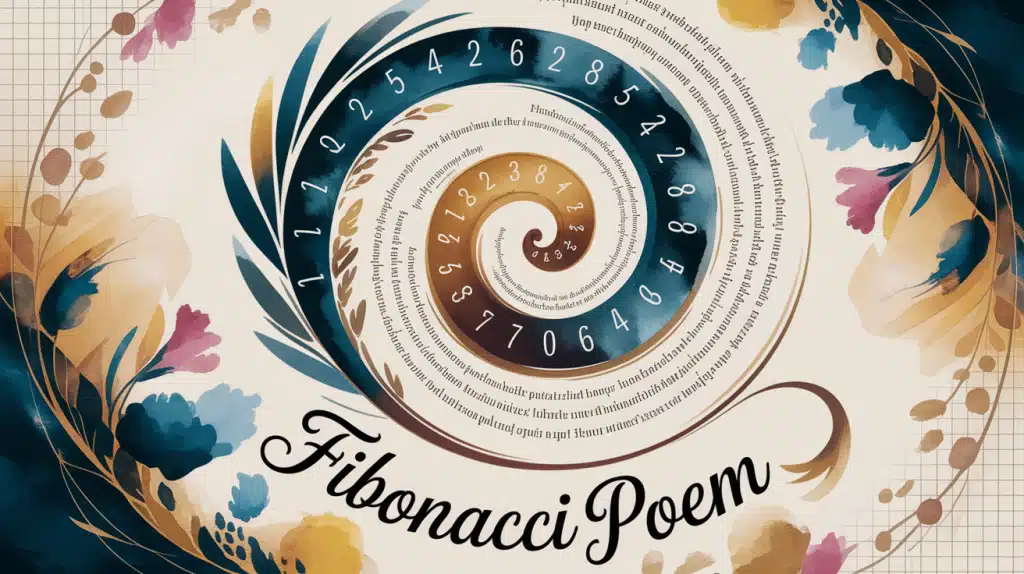Ever noticed how math and poetry seem like opposite worlds? Think again. The Fibonacci sequence—that famous pattern where each number adds the previous two—creates more than just mathematical beauty. It shapes poems too.
Writers use these numbers to count syllables, forming verses that mirror nature’s own patterns. From six-word stories to complex stanzas, this mathematical structure gives poets a unique framework. The result? Words that flow with the same rhythm found in flower petals and seashells.
Ready to see how numbers become verses? Let’s explore how Fibonacci poems work, why writers love them, and how you can create your own mathematical masterpiece.
What is a Fibonacci Poem?
A Fibonacci poem—often called a Fib—is a short, structured poetic form that uses the famous Fibonacci sequence to determine the number of syllables in each line.
The Fibonacci sequence is a series of numbers where each number is the sum of the two before it:
0, 1, 1, 2, 3, 5, 8, 13, …
For poetry, the sequence (usually starting from 1) is applied like this:
1 / 1 / 2 / 3 / 5 / 8
That means:
-
The first line has 1 syllable
-
The second line has 1 syllable
-
The third line has 2 syllables
-
The fourth line has 3 syllables
-
The fifth line has 5 syllables
-
The sixth line has 8 syllables
Key Features:
-
Usually a 6-line poem (but can be extended).
-
Follows a precise syllabic pattern based on the Fibonacci sequence.
-
Merges mathematical order with poetic creativity.
-
Ideal for themes that reflect growth, nature, time, or emotion.
Why It’s Special:
The Fibonacci sequence is found in nature (spirals in shells, flower petals, pinecones), and by using it in poetry, writers connect language with natural structure, creating verses that are both concise and meaningful.
Would you like a visual infographic or a video script explaining this too?
Fibonacci Poem Examples
Here are several examples of Fibonacci poems, each crafted with the classic 1 / 1 / 2 / 3 / 5 / 8 syllable structure.
These demonstrate how diverse themes—nature, emotion, time, and reflection—can be expressed within this mathematically inspired form.
Example 1: Fibonacci Poem About Nature
Leaf
falls
silent
on still pond—
ripples tell their tale,
fading like breath into stillness.
Example 2: Memory
You
were
a spark
in the dark,
gone before I blinked—
but I still see light when I close
my
eyes.
Example 3: Sunrise
Red
sky
rising—
whispers light
across sleeping hills,
pulling the world into morning.
Example 4: Fibonacci Poems about Time
Now
gone—
the hour
I held tight.
It slipped through like wind,
leaving behind the weight of then.
Example 5: Passion
Burn
me
with words—
not anger,
but those you once breathed
when love was louder than silence.
Fibonacci Poems in Education
Teachers use Fibonacci poems to blend math and language arts. This cross-subject approach helps students see connections between different fields of study.
Math Meets Creative Writing
Students learn the Fibonacci sequence through hands-on poetry creation. They count syllables while practicing addition. A student who struggles with abstract numbers often grasps the concept through words.
Middle school teachers report success using this format. Students write about their interests while practicing mathematical patterns. Sports fans create poems about basketball. Animal lovers write about pets. The personal connection makes learning stick.
Building Language Skills
The syllable counting improves several abilities:
- Vocabulary expansion (finding words that fit)
- Phonemic awareness (breaking words into parts)
- Reading rhythm (understanding syllable stress)
- Concise writing (every word matters)
Classroom Activities That Work
Teachers share these proven exercises:
- Group poems – Each student writes one line
- Theme challenges – Everyone uses the same topic
- Math visualization – Draw spirals alongside poems
- Peer editing – Students check each other’s syllable counts
How to Write Your Own Fibonacci Poem?

Writing a Fibonacci poem becomes simple once you know the steps. Follow this guide to create your first mathematical verse.
Start With Single Words
Begin with two one-syllable words. Pick short, strong words like:
- Sun / Moon
- Cat / Dog
- Love / Hope
- Red / Blue
These first words set your poem’s tone. Choose words that connect to your theme. They become your foundation.
Build Your Lines Gradually
Add syllables following the sequence:
- Lines 1-2: One syllable each
- Line 3: Two syllables (1+1)
- Line 4: Three syllables (1+2)
- Line 5: Five syllables (2+3)
- Line 6: Eight syllables (3+5)
Count carefully. Clap out syllables if needed. Remember: “butterfly” has three beats (but-ter-fly).
Choose Your Theme
Strong themes make better poems. Consider:
- Seasons – Spring growth, winter snow
- Emotions – Joy building, sadness fading
- Daily moments – Morning coffee, evening walks
- Nature scenes – Ocean waves, mountain views
Pick something you know well. Personal topics create authentic poems.
Common Mistakes to Avoid
Watch for these pitfalls:
- Forcing rhymes – Fibonacci poems don’t need to rhyme
- Wrong syllable counts – Double-check words like “fire” (two syllables)
- Incomplete thoughts – Each poem should express one clear idea
- Starting too complex – Keep first attempts simple
Pro Tip: Write your poem on paper first. Cross out syllables as you count. This visual method prevents errors.
Practice makes perfect. Your first poem might feel awkward. That’s normal. Keep writing, and the rhythm becomes natural.
Digital Tools for Online Syllable Counters
Bringing poetry and mathematics together is a fun and rewarding challenge, but it doesn’t have to be done alone.
Accurate syllable counting is the backbone of a Fibonacci poem. These tools help ensure your lines match the sequence correctly:
Breaks down syllables word-by-word with pronunciation guides and dictionary definitions.
Helpful for longer lines or when experimenting with extended Fibonacci poems.
Pro Tip: Read your poem aloud as you write—sound and rhythm are as important as syllables.
Conclusion
So now you understand how mathematics and poetry connect through Fibonacci sequences. This unique form gives writers a framework that mirrors nature’s own patterns—from seashells to sunflowers.
Teachers use these poems to make math tangible. Students count syllables while creating art. Writers find freedom within mathematical boundaries.
The 1-1-2-3-5-8 pattern seems simple. Yet it produces verses that stick in memory. Why? Because our brains recognize these natural proportions. The same ratios that make flowers beautiful make poems flow.
Try writing one today. Start with two single syllables. Build each line by adding. Watch your words spiral into something unexpected. Share your creation with others. Who knows? You might inspire someone else to see math differently. Numbers and words aren’t opposites—they’re partners in creating beauty.
Explore more articles on academics, motivation, and personal growth.






















